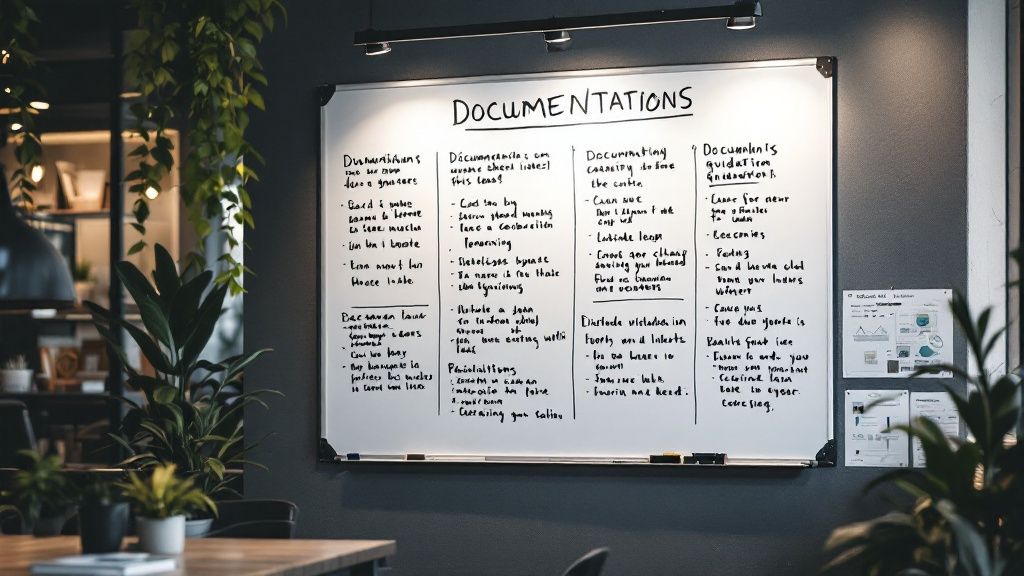Learn how to write effective code documentation that improves developer collaboration, reduces onboarding time, and streamlines maintenance. Explore best practices, tools, and emerging trends like AI integration and Documentation as Code.

Imagine assembling complex furniture without instructions. The frustration is palpable. Similarly, code documentation provides the crucial instructions for software. It acts as a bridge, translating the intricate workings of your code into understandable terms for those who use, maintain, and build upon it. Without this clear guidance, even the most elegant code can become an impenetrable maze.
Clear documentation offers numerous advantages, impacting individual developer productivity and overall project success. For instance, onboarding new team members becomes significantly smoother. Well-documented code allows them to quickly grasp the project’s structure and contribute effectively. Additionally, good documentation simplifies debugging. When code is clearly explained, identifying and resolving errors becomes much faster, saving valuable time and resources. This streamlined debugging process arises from the increased visibility of logical errors and inconsistencies within well-explained code.
Furthermore, documentation benefits not only your colleagues but also your future self. Revisiting code months later, clear documentation serves as a reminder of your original thought process. This facilitates easier updates and feature additions, minimizing the risk of introducing new bugs and ensuring long-term maintainability. It’s like leaving a clear, detailed message for your future self, instead of deciphering cryptic notes. This foresight allows for smoother transitions and continued project momentum. Now, let’s delve into the various types of documentation available.
Just as various instruction types exist, different approaches can be taken to document code. These range from simple code comments to extensive external documents. Inline comments, for example, offer concise explanations within the code itself, clarifying the purpose of specific sections. These are essential for providing context and enhancing readability. However, larger projects often demand more comprehensive documentation outside the codebase. This could encompass API documentation, user manuals, tutorials, and even video walkthroughs. API documentation, for instance, explains how to interact with your code’s functions, while user manuals guide end-users on software operation.
The optimal documentation strategy hinges on project complexity and audience needs. A small script might require only inline comments, whereas a large application benefits from a multi-faceted approach. The goal is to create a clear pathway for anyone interacting with your code, be it developers, testers, or end-users. This approach ensures code understandability, usability, and maintainability, laying the groundwork for a successful project. Now, let’s explore the best practices for creating effective documentation.

A thoughtful approach to documentation ensures that code remains understandable, usable, and maintainable. But how do we achieve truly effective documentation? It involves more than just adding comments; it’s about crafting a clear, concise, and comprehensive guide. This requires implementing best practices that enhance navigability, comprehension, and maintainability.
Think of documentation as providing directions. Vague instructions are unhelpful. Similarly, documentation should be precise and to the point. Use clear, simple language, avoiding jargon whenever possible. For example, instead of saying “Utilize the function to instantiate the object,” write “Use the function to create the object.” This directness ensures comprehension for all readers, regardless of their technical expertise. This clarity lays the foundation for effective communication and understanding.
While conciseness is vital, comprehensiveness is equally crucial. Documentation should cover all aspects of the code, from overarching architecture to specific functions and classes. Explain not only what the code does, but also why. Imagine a recipe omitting key steps. Similarly, incomplete documentation leads to guesswork, wasted time, and potential errors. Thorough documentation provides a complete picture, guiding users effectively.
Consistent formatting and terminology enhance user-friendliness, much like a consistent writing style in a book. Establish a style guide and adhere to it. This could include formatting code examples, using headings, and choosing consistent terminology. For instance, use a single term for a specific data structure, instead of interchanging “array,” “list,” and “collection.” This consistency improves navigation and understanding. With a unified approach, the documentation becomes a cohesive and user-friendly resource.
Code constantly changes, and documentation must keep pace. Outdated documentation is misleading and detrimental. Integrate documentation updates into your workflow. When modifying a function, update its documentation. This ongoing maintenance ensures its reliability and value as a resource. Consistent updates ensure that the documentation remains a true reflection of the code.
Consider the different documentation types and their appropriate uses. Inline comments explain specific code blocks, API documentation formally specifies code interaction, and user manuals guide end-users. The chosen strategy depends on the project and audience. The core purpose is to make code understandable and usable. With this in mind, let’s explore the tools and technologies available for creating and managing documentation.

Continuously reviewing and revising documentation keeps it aligned with the evolving codebase. Using the right tools and technologies is essential for efficient and effective documentation. Just as a carpenter needs specific tools, developers need specialized tools for creating high-quality documentation. These tools streamline the process, improve readability, and ensure consistency.
Tool selection depends on project needs, team workflow, and documentation type. Simple text editors with Markdown support, like VS Code or Sublime Text, suffice for smaller projects. For larger projects with complex APIs, dedicated documentation generators are preferable. These different tools cater to varying project scales and complexities.
Documentation generators automatically create documentation from your code. They analyze the codebase, extracting information like function signatures and comments to generate formatted documentation. Tools like Doxygen, JSDoc, and Sphinx are popular choices. They drastically reduce manual effort, ensuring consistency and accuracy. This means that code changes quickly reflect in the documentation, minimizing discrepancies. It’s akin to having a system that automatically updates instructions with every design change.
Dedicated documentation platforms enhance workflows by providing centralized repositories. Platforms like Read the Docs and GitHub Pages host documentation online, enabling version control, search functionality, and collaboration. This structure makes information readily available to users and simplifies developer contributions. It’s like having a well-organized library instead of scattered notes.
While text is essential, rich media greatly improves clarity and engagement. Diagrams, videos, and interactive tutorials enhance understanding, especially for complex concepts. A video demonstrating API function usage can be far more effective than a written explanation. This is analogous to including visual aids in furniture assembly instructions. Rich media enhances effectiveness and accessibility, making understanding your project as effortless as possible. Using the right tools and technologies ensures clarity, accuracy, and accessibility, creating a valuable resource for both your team and your users. Let’s now explore the benefits of using documentation templates.
Using the right tools and technologies makes your code a valuable asset. Starting documentation from scratch can be daunting. That’s where templates come in. Like blueprints, they offer a pre-designed structure adaptable to your needs, accelerating the process and promoting consistency.

Templates offer several advantages. They enforce best practices by including placeholders for essential information like function descriptions and parameters. This ensures comprehensive coverage. They also maintain consistent style and structure, which is especially valuable for large projects with multiple contributors. It’s like ensuring everyone on a construction site uses the same measurements. Finally, templates save time by providing a starting point.
Various templates exist, each serving a different purpose. Choosing the right template depends on the type of documentation you’re creating.
Templates streamline documentation, saving time and ensuring consistency. However, automation takes this efficiency further. Automated documentation generators create and maintain documentation with minimal manual intervention. This allows you to focus on coding while the tool handles documentation.
Consider the time spent writing documentation. Automated tools significantly reduce this effort, especially for large projects. They also enforce consistency, ensuring a unified style regardless of the author. For example, an automated tool can enforce a specific function documentation format, preventing discrepancies and improving readability.
Several tools automate documentation. Choosing the right one depends on project needs and programming languages. JSDoc, popular for JavaScript, allows documentation comments within code, which are then processed to generate HTML documentation. Doxygen supports multiple languages, generating documentation in various formats like HTML, PDF, and LaTeX. Sphinx, commonly used for Python, offers powerful documentation creation and management.
Automated tools act like real-time translators, converting code into human-readable documentation. They analyze the codebase, extracting information like function names and comments to generate structured documentation. This keeps documentation synchronized with code. If you change function parameters, the documentation automatically updates. This prevents outdated documentation, ensuring accuracy.
This automation not only saves time but also improves accuracy. Generating documentation directly from code reduces human error, minimizing inconsistencies, especially crucial for APIs where precise documentation is vital. Automating documentation enhances reliability and usability, simplifying understanding and integration. Next, we’ll discuss the importance of maintaining documentation.

Automating documentation enhances code reliability and usability. However, even with automation, maintaining documentation requires ongoing effort. Like a garden, it needs regular tending to remain relevant and valuable. This involves strategies for ensuring documentation stays current, accurate, and accessible.
Using an outdated map can lead you astray. Similarly, outdated documentation misleads developers, introduces errors, and hinders productivity. When code changes, documentation must follow suit. This requires a systematic approach to updating documentation alongside code modifications, ensuring accuracy and preventing confusion.
Effective documentation maintenance requires its integration into the development process. Treat documentation as essential as the code itself. Update relevant documentation whenever modifying a function, adding a feature, or fixing a bug. This proactive approach prevents documentation from becoming outdated.
Documentation, like code, benefits from version control. Using systems like Git tracks changes, allows reverting to previous versions, and manages contributions. This is especially valuable for larger projects with multiple developers, providing a clear modification history, facilitating collaboration, and enabling easy restoration of older versions.
Periodic reviews and audits are essential for identifying gaps, inconsistencies, and outdated information. Schedule regular review sessions, perhaps during sprint planning, to check for accuracy and completeness. Assign different sections to different team members or use automated tools to check for broken links or outdated examples. This helps maintain quality.
For open-source projects, community involvement enhances documentation maintenance. Encourage users to report errors, suggest improvements, and even submit updates. This distributes the workload and brings fresh perspectives, leading to more comprehensive and user-friendly documentation.
These strategies transform documentation into a living resource evolving with your code. Maintaining documentation is not just a best practice; it’s an investment in project success. By ensuring up-to-date and accurate documentation, you empower developers, improve collaboration, and enhance code health and maintainability. Just as a well-maintained garden thrives, so will your project with well-maintained documentation. Finally, let’s conclude with the overall value of documentation.
Up-to-date and accurate documentation empowers developers, fosters collaboration, and improves code maintainability. Effective code documentation isn’t just a skill, it’s an investment in your project, team productivity, and your own well-being.
Documentation bridges the gap between complex software logic and human interaction. This bridge facilitates understanding, reduces errors, and accelerates development. Well-documented code is easier to understand, maintain, and extend. For developers, it’s a reliable map through unfamiliar territory, guiding them through the code and its purpose.
Documentation is often an afterthought. However, prioritizing it from the start builds a robust and maintainable codebase. Like creating blueprints before building a house, integrating documentation into the development process from the beginning ensures its accuracy and relevance.
While initially seeming burdensome, the long-term benefits of documentation are substantial. Clear and comprehensive documentation saves time and resources by reducing debugging time, onboarding time for new team members, and the effort required to understand older code. This ultimately contributes to a more efficient and successful project. Good documentation is like having instructions for a complex machine, ensuring its understandability and maintainability long after its creation.
Looking for a tool to streamline your documentation process and elevate your code’s clarity? Check out DocuWriter.ai (https://www.docuwriter.ai/). It leverages AI to automate the generation of accurate and consistent documentation, saving you valuable time and effort while improving your project’s overall quality.